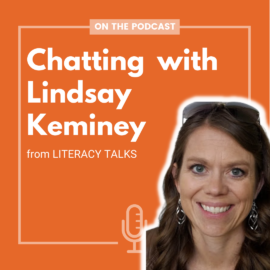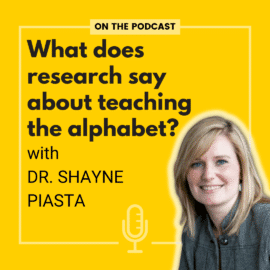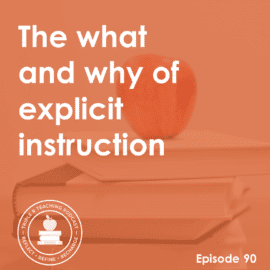
TRT Podcast#48: SOR Bootcamp #4 – What IS structured literacy, anyway?
Structured literacy is all the rage these days, but what exactly is it? Today we’ll discuss the HOW and the WHAT of structured literacy. Share this 6-week podcast series with friends who want to learn more about the science of reading.
Key Practices (the HOW of structured literacy)
- Explicit
- Systematic
- Sequential
- Cumulative
- Diagnostic
Elements (the WHAT of structured literacy)
Listen to the episode here
Full episode transcript
Hello, and welcome to the fourth episode in our Science of Reading Bootcamp. Today is another day that's a little bit more theory and less practical, but I promise next week we're going to get into the practical - the nuts and bolts. But this is really important to understand!
We're going to talk today about what structured literacy is. You hear that being tossed around a lot. You might wonder what exactly that means. How do you teach in a structured way? Does structured literacy equal boring?
I know that's certainly what I thought for a while. I really didn't want anything to do with it until I started studying the science of reading and realized there were some problems with my approach. I actually did an episode way back on April 19th, 2021. It was Episode 42, and I described the difference between balanced and structured literacy.
In this episode today, we're just going to zero in on structured literacy. What is it? How do you teach with a structured approach?
Well, to understand structured literacy, you only need to know two things: you need to know the key practices in structured literacy, and you need to know the elements.
The key practices are basically qualities of good teaching. You should be using those in whatever you're teaching, whether that's math, science, or reading.
I've chosen the word "elements" to refer to the content. You're going to be using these key practices as you teach this specific content.
In today's episode, I want to talk about the practices and the elements. There are five qualities of good teaching when it comes to structured literacy.
Number one: when you teach in a structured way, you are explicit. You come right out and say what you want your students to know! It's not a guessing game. You just come right out and say it.
Number two: be systematic. Being systematic means that you have predictable routines. You're not just making it up as you go along. For people who like to fly by the seat of their pants, being systematic can be hard. It can be hard to have routines that work for you, but students really respond to them. It's definitely something to figure out. A lot of programs come with routines they want you to use. I would say you can certainly modify them to fit your personality and your style, but in general, you want to stick to them as much as possible, especially if students will be using those same routines in other grades.
Number three: being sequential is the third key practice of structured literacy. That means you're teaching in order from easy to difficult. In other words, when you're teaching phonics, you're going to start with vowels, consonants, CVC words, and gradually move up to more complicated concepts, such as CVCE words, r-controlled vowels and so on.
Number four: Another practice is being cumulative. The concepts are reinforced and practiced over time. We don't just teach something and forget about it. We review it - a lot! A great place to do that is at your literacy centers. If you are teaching phonics in small groups at those literacy centers, that's where you give them things they've already learned, but you give them fun ways of practicing it.
Finally, number five: another key practice of structured literacy is being diagnostic. You're monitoring progress and adjusting instruction based on student needs. This can be tricky if you have a program and someone expects you to be exactly on the same page as everyone else in your building every day. That's when you need to educate somebody about what it means to be a diagnostic teacher, how you don't just teach the next thing because the book says to, but you teach it because your students are ready for it.
Some teachers solve this issue by meeting with students in small groups to help them understand the concepts they didn't grasp with the whole class. Personally, I think the best approach is to assess everyone and then teach phonics in small groups, but we'll get to that later in the series.
Those are the five key practices of structured literacy. They're qualities of good teaching. You should do them no matter what subject you teach. You want to be explicit, systematic, sequential, cumulative, and diagnostic. That's the first thing you need to know.
The second thing you need to know about structured literacy is that there are certain things we're going to teach within structured literacy. We're going to be explicit, systematic, sequential, cumulative and diagnostic when we teach these key elements. Now I actually have a whole blog series that I did with my colleague, Becky Spence, of "This Reading Mama", all about what structured literacy is and I will link to those episodes in the show notes.
Right now, I'll go through them very quickly. The first one is phonology. Phonology - phone - has to do with sound. That's about phonological awareness and specifically phonemic awareness. You remember that that has to do with the individual sounds in words, so we teach that.
We also teach sound-symbol association. in other words, phonics. The sound, /ē/, can be represented in a lot of ways. It can be represented with a single "e", as in "me". It can be represented with e-consonant-e, as in "here" and so on. Sound-symbol association is matching phonemes to graphemes. We're going to get very specific in our phonics instruction. We can teach that we spell the /k/ sound in different ways. We usually use "c" to spell /k/ before "a", "o", and "u", and we usually use "k" to spell the sound /k/ before "e" and "i". We use "ck" to spell /k/ at the end of a single syllable, short vowel word. You might teach even more complex spellings depending on the age or grade of your students.
The next element of structured literacy is syllable instruction. I'm not talking about clapping syllables, that goes back to phonology. I'm talking about teaching about the six syllable types and syllable division rules. You can learn more about this in the blog post series that I'll link to in the show notes. We also go into great detail about syllables and syllable instruction inside our online course, "Teaching Every Reader".
The next element is morphology. Morphology refers to morphemes, the smallest parts of words that have meaning. Things like prefixes, suffixes, and root space words. You'll be focusing more on that in the upper grades, but you can certainly do some of that in the lower grades as well.
Finally, we have syntax and semantics. That has to do with grammar and sentence structure, the mechanics of language. With our youngest students, we'll be addressing a lot of this through read alouds. But as students grow as readers, we can teach them these things and how to apply them to their own reading and writing.
That was today's episode. Let's review really quickly. If someone asks you, "What is structured literacy?", you can say, "Well, it has to do with how you teach and what you teach". In reference to how you teach, you should be explicit, systematic, sequential, cumulative, and diagnostic. In regards to what you teach, you teach your students phonology, phonics, syllable types and syllable division, morphology, and then syntax and semantics.
There's a lot to remember in this episode! I recommend heading to the show notes, themeasuredmom.com/episode48 and printing the transcript, so that you can have all of this at your fingertips and you don't have to remember all of it. Remember that our online course "Teaching Every Reader" will show you how to teach reading according to the science of reading and with a structured literacy approach, and that opens on October 4th, 2021.
Finally, the last two weeks of this Science of Reading Bootcamp are going to get very specific! Next week we'll talk about what the research says about the Big Five:phonological awareness, phonics, fluency, comprehension, and vocabulary, and how that applies to how you teach them. Then the last week, we'll discuss the nuts and bolts of the science of reading.
We'll see you next week!
Sign up to receive email updates
Enter your name and email address below and I'll send you periodic updates about the podcast.
More episodes in the Science of Reading Bootcamp
- Episode 1: 3 reasons why there’s so much disagreement around the science of reading
- Episode 2: How we read and remember words
- Episode 3: The Simple View of Reading and Scarborough’s Reading Rope







Leave a Comment